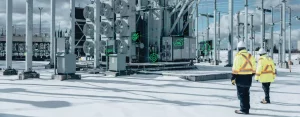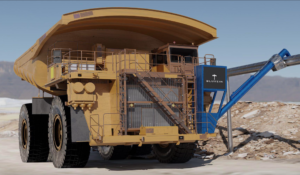Just prior to the recent Electric Mine 2024 conference in Perth, Western Australia, we caught up with Arnaldo Bertazzi, VP Industry Network Leader – Industries, at Hitachi Energy. He says that the key to electrification in mining is to start small and think big. Electricity will be the backbone of the entire mine energy system, and digitalisation is one of the fundamental technology areas this is enabling the energy transition in mining.
Arnaldo Bertazzi, VP Industry Network Leader – Industries, at Hitachi Energy

Q One of your most anticipated solutions in mining electrification is a high-voltage fast charger – can you provide an update on this?
We remain committed to supporting the electrification of mining and developing the right charging solutions for our customers’ fleet electrification. Two key focus areas of Hitachi Energy are standards and interoperability. We have been focused on CharIN standards to extend MCS for mining, especially X-MCS to extend the power, voltage, and ruggedised MCS for the mining environment, and have been working with miners and other industry partners to get this right. Our investigations have shown there is no one-size-fits-all solution, so we support using high power static charging and dynamic charging. These solutions will find applications beyond mining, in marine and rail environments. Safety and reliability are critical to the success of heavy haul flash charge solutions and we are utilising our bus charging solution and scaling it up for mining. The recent acquisition of eks Energy is a strategic investment in the charging solutions space (such as the Waratah 840 MW/1680 MWh super battery) and forms part of our portfolio of technologies that can scale up to the largest capacities.
Q How will digitalisation help achieve the all-electric mine and can you give some examples of how Hitachi Energy is delivering in this space?
Hitachi Energy identifies digitalisation as being a key component to the overall success of decarbonising mining activities, however we also see it as an enabler and accelerator towards achieving an all-electric mine. Digitalisation is not only functional to electrification – it also potentially enables higher flexibility and efficiency across all mining processes, as well as improving safety. In fact, it permits the optimisation of logistical and relevant transactions, optimisation of demand/production balance, and minimisation of operational costs, eg demurrage cost. Furthermore, when applied to asset management, it can easily support prognostic maintenance of assets based on the online knowledge of the status and call to service of any specific asset. Additionally, improved and greater safety is achievable through autonomous vehicle control and ‘digital fencing’ obtained through wearable sensors. Just one example, the electrification of underground equipment reduces the need for ventilation, while also generating economic advantage when associated with a smart control of the ventilation. Finally, if at least part of the electricity is produced by the mine with solar and/or wind, digital control and supervision will unleash the whole economic potential of the associated µ-Grids. The transition to an all-electric mine will involve major capital
Hitachi Energy is a global leader in transformers, offering liquid-filled and dry-type transformers, as well as services for complete life-cycle support

investments, and those investments will typically take multiple years to realise. Investments in grid infrastructure, electric mining vehicles, charging infrastructure, and renewable energy projects are complex and can have interdependencies on each other. As such, it is critical to understand how to transition from today’s operating scenario to the future scenarios that will play out over time. The ability to understand and digitally replicate today’s mining operations, processes, and efficiencies – a so-called “baseline” mining scenario – can be a huge advantage in planning the electrification transition. With such a replica, the production targets, operational processes, energy demand landscape, and carbon position can be studied, optimised or constrained according to business objectives. Recent advancements in AI and ML can also rapidly speed up the process of achieving a digital replica. Electrification and digitalisation work together to achieve a mine with lower carbon footprint and higher economic efficiency. Energy management systems, energy trading software, and certification of renewable energy use, will become mandatory for an electrified mine. The company’s energy and digitalisation experts support customers with digital landscapes and the supporting solutions that will be deployed within the investment and energy transition strategies defined for our customers. Solutions spanning the all-electric mine digital landscape include network management systems and solutions facilitating grid scale monitoring, control and automation of generation, transmission, distribution, and renewable energy assets. Energy portfolio management offers an end-to-end solution for mission-critical investment, regulatory, operating and trading decisions, and asset and work management solutions support the optimisation of portfolio resources to balance performance, risk, and cost.
Q In some regions, mines are already highly electric. Are there lessons to be learned from these operations when mine operators are transitioning to electric?
The first lesson we can learn is that one size does not fit all. Each mine, region, and type of mineralisation has its own unique challenges. Flexibility is key, and different miners have different reasons for electrifying. Cost and energy security have been at the forefront in driving these highly electric mines, and this will continue as renewables drive down the price of energy. A second lesson from this is the importance of renewables integration and power quality. As we see more reliance on electricity for energy, we need more technology to ensure the mine has the resilience to maintain operations during complex failures. The amount of electricity required will be enormous. Many mines will see their demand soar and will need to plan accordingly. We must also recognise the role of diesel-elimination in improving the air quality in underground mines. In that regard, not all fossil fuels are equal – eliminating diesel from underground mines has real, additional health benefits for mine workers besides the obvious sustainability considerations.
Q How can mine sites effectively leverage electrification to enhance smart operations, incorporating data analytics and improving performance?
Mine operations can strategically harness electrification to enhance smart operations, integrating data analytics, and driving performance improvements. Initially, electrification emerged as a pathway to enhance health, safety, and environmental (HSE) conditions in underground mining, while simultaneously allowing for cost savings in expensive ventilation systems and (CE) equipment maintenance. Beyond these initial benefits, building synergies between electrification and digitalisation can transform into a comprehensive solution that enables dynamic monitoring, control, and optimisation of mining operations. This integration has the potential to significantly influence the cost structure of an operation and reinforce sustainable practices within the industry. At Hitachi Energy, our unwavering focus lies in the seamless integration of electrification and digitalisation for decarbonisation. Through our product portfolio of electrical equipment and systems complemented by innovative digital solutions, we strive to lead the charge toward a more sustainable and efficient mining landscape.
Q What are key considerations for an electric mine and ensuring sustainable operations?
Definitely power quality and matching supply with demand. The cost of variable renewable energy is already lower than fossil fuels. Electrification is inevitable. However, the key challenge is matching renewable power to the reality of continuous mining. I must also add – emissions tracking, proper management, and settlement of PPAs, carbon credits trading, proper monitoring and control of all electrical equipment and systems through our innovative IoT and communication technologies, asset performance management systems, network control, etc.
Q What are the main drivers of electrification?
There are many drivers, but we see the main ones being cost, energy security, energy diversity, the elimination of diesel particulates in underground mines, shortening the energy supply chain, social licence, improved reliability, and reduced maintenance. Reducing carbon emissions is often the main driver, accelerated by the decreasing cost of energy. This will enable a switch to electric mines, with the need to comply with new laws and regulations related to HSE and emissions.
Q Will electric fleets require mines to have more power, more power reliability, plus more power redundancy and storage? How is Hitachi Energy helping mining clients deliver on these?
Absolutely. This will be a big factor especially for directly shipping ores like iron and aluminium, where haul fleets use much more energy than the mine plant. Hitachi Group and Hitachi Energy have a wide range of solutions that have been proven to help our mining clients navigate the energy transition. For instance, Hitachi Energy is promoting high-power static charging which allows the utilisation of haul trucks to be very high, while offering flexibility and costs similar to diesel. Additionally Hitachi Energy and BluVein, an innovator in dynamic charging technology, have signed a Memorandum of Understanding (MoU) to accelerate the electrification of heavy haul mining fleets and solve one of the biggest challenges in decarbonising mine operations. Hitachi Energy’s advanced power electronics and digital charging technologies allow BluVein’s e-rail charging technology to deliver electricity safely and reliably to haul trucks of up to 400 metric tons while transporting materials. The collaboration will fast-track the development of a high-powered, fast, and flexible dynamic charging solution for surface and underground mines and quarries in Australia and across the globe. BluVein will focus on its leading-edge e-rail and truck connections, which Hitachi Energy will further complement with advanced power electronics and digital solutions to power and monitor the whole system.
The Hitachi Energy collaboration with BluVein combines solutions to deliver electricity safely to battery-electric trucks of up to 400 t

Q As mine operators are adopting digital transformation, what are the first steps toward change?
As mentioned earlier, understanding the “as is” state of the mining operation, energy demand, and carbon position is an excellent first step. These steps need not be all-encompassing; they can be segmented to deal with specific issues and aligned with the overarching corporate objectives of the customer. Digital transformation will include managing a “system of systems” to fully leverage the benefits and ensure the multiple constraints of the evolving mine will continue to deliver production targets and return on investment.











